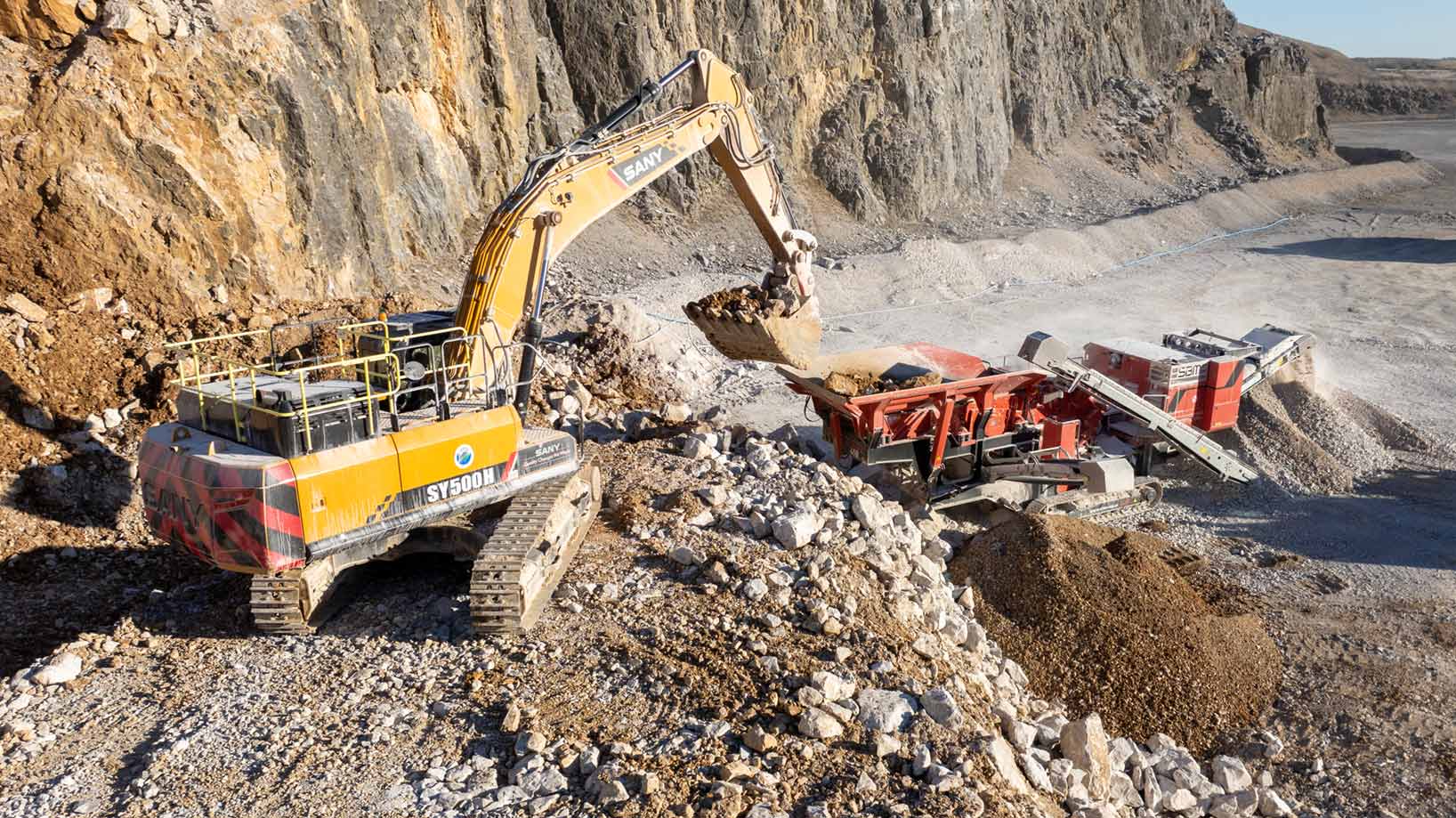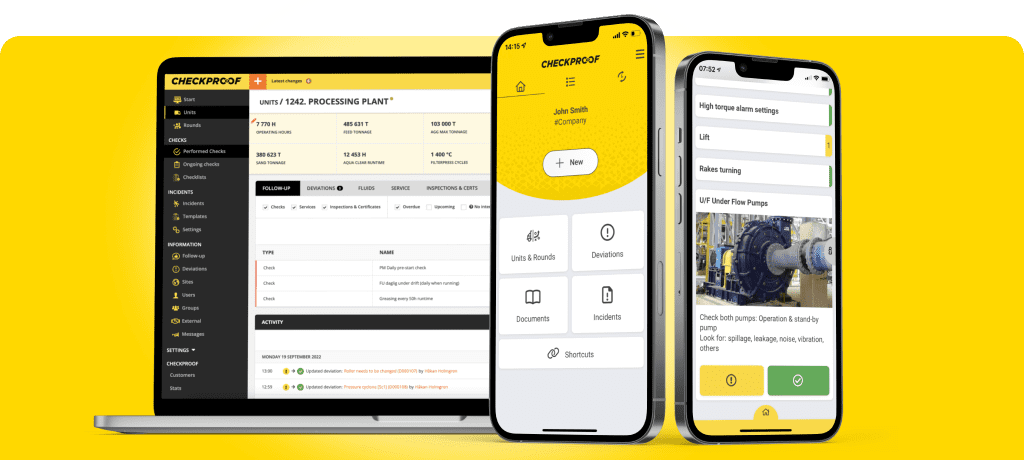If you work with maintenance management within the construction materials industry, predictive and preventive maintenance will be on your radar. Each method is a proactive maintenance practice, yet they can offer distinct advantages and drawbacks, supporting different operational needs and objectives. We break down both maintenance strategies – when they should be applied, how they compare, and what to consider when choosing which maintenance approach suits your business best.
In this article, we will cover:
- Predictive Maintenance – what is it?
- Advantages & Disadvantages of Predictive Maintenance
- Preventive Maintenance – what is it?
- Advantages & Disadvantages of Preventive Maintenance
- Predictive vs Preventive Maintenance
- Maintenance strategy comparison
- How CheckProof Supports Predictive and Preventive Maintenance
Predictive Maintenance – what is it?
Predictive Maintenance is a proactive maintenance strategy that leverages data analytics and machine learning algorithms to predict equipment failures before they occur. By continuously monitoring performance indicators on assets, this method aims to identify potential issues and trigger maintenance activities, optimizing asset availability, and minimizing downtime.
Identifying and setting parameters for the peak performance of assets and the threshold at which it may fail, is a key component of a successful predictive maintenance routine. Tapping into historical data allows businesses to let the asset approach near equipment failure without inducing actual failure. The idea being to avoid premature repairs, parts replacement, or superfluous maintenance scheduling – optimizing resource utilization effectively. Predictive maintenance requires a connected plant. In larger companies within the construction materials space, integrations are often associated with telematics and IoT (Internet of Things), allowing the information from operating time, fuel levels, and more to become insights that can trigger maintenance tasks.
Examples of predictive maintenance can include monitoring the following:
- Temperature
- Sounds
- Vibrations
- Error codes
- Speed
The above can contribute to early warning signs of part failure.
Advantages & Disadvantages of Predictive Maintenance
| Pros | Cons |
|---|---|
| Increased asset availability: By detecting potential failures in advance, Predictive maintenance helps minimize unplanned downtime and ensures uninterrupted operation of critical assets. | Expensive Investment: Implementing a predictive maintenance program requires investment in sensor technology, data analytics tools, and employee training, which can be costly upfront, however for larger-scale companies, the costs would be recuperated with prolonging the lifespan of assets. |
| Cost Savings: PdM enables organizations to schedule maintenance activities based on actual equipment condition, reducing unnecessary maintenance and extending asset lifespan. | Data Complexity: Managing and analyzing large volumes of data generated by predictive maintenance systems can be challenging, requiring specialized skills and resources. |
| Improved Safety: Proactively addressing equipment issues mitigates the risk of accidents and contributes to workplace safety for personnel. | False Alarms: In some cases, predictive maintenance systems may generate false alarms or incorrect predictions, leading to unnecessary maintenance activities and potential disruptions. |
Preventive Maintenance – what is it?
Preventive Maintenance is also a proactive maintenance strategy that involves regularly inspecting and proactively maintaining assets and equipment by scheduling tasks aimed at preventing equipment failures and degradation. By creating parameters for preventive maintenance and adopting predefined maintenance schedules, businesses will perform regular servicing, replacements, and repairs to optimize asset availability and performance. This can be done by setting calendar-based schedules or usage-based triggers, so if an asset has gone through a certain number of production cycles, this will trigger a task to perform preventive maintenance. Applying preventive maintenance can mitigate machines running to failure and breaking down incurring costs and a stop in production.
Advantages & Disadvantages of Preventive Maintenance
| Pros | Cons |
|---|---|
| Planned & Proactive Maintenance: Preventive maintenance lets organizations schedule maintenance activities during planned downtime, minimizing disruption to operations. It creates a structured familiarity for staff allowing them to spot deviations more easily. | Premature maintenance: Performing maintenance tasks based on fixed schedules may result in unnecessary servicing of equipment, leading to increased costs and resource utilization. |
| Increased Asset Longevity: Regular servicing and inspections help identify and address minor issues before they escalate, extending the lifespan of equipment and reducing the need for costly replacements. | Over-reliance on a fixed schedule: Despite regular inspections, preventive maintenance may not always detect impending failures or issues, causing unexpected breakdowns and downtime as it wasn’t part of a scheduled-maintenance routine. |
| Compliance-Ready: Following preventive maintenance schedules ensures regulatory compliance and adherence to industry standards, mitigating the risk of fines and penalties. | Limited Flexibility: Fixed maintenance schedules may not account for variations in equipment usage, environmental conditions, or operational demands, potentially leading to inefficiencies and less desirable maintenance outcomes. |
Predictive vs Preventive Maintenance
Predictive maintenance may be considered the Rolls-Royce of maintenance standards, and it does offer higher reliability in predicting asset performance. Yet, bearing in mind the large upfront investment coupled with the data handling needed, it’s important to identify which critical assets require predictive maintenance and consider a combined approach. The table below compares key considerations between both maintenance strategies.
Maintenance Strategy Comparison

How CheckProof Supports Predictive and Preventive Maintenance
CheckProof’s digital platform can support organization’s predictive and preventive maintenance strategy.
For example:
- CheckProof’s software for Pigeon devices, transfers data directly from the control systems of your production units into CheckProof’s platform. This lets you create automated triggers for maintenance tasks in the system based on factors such as operating hours, produced quantity, temperature, or pressure levels, enabling a predictive maintenance approach.
- CheckProof’s OEM integrations lets companies stream telematics data from rollers, pavers, and other machines and vehicles from different manufacturers into its platform, where maintenance tasks can be triggered from fault codes, as well as at preset intervals based on usage.
- CheckProof supports preventive maintenance by digitizing your workflow to ensure all information is available when and where it’s needed. Assign mandatory tasks, due dates and follow ups, adding automation to your preventive maintenance process will boost efficiency while minimizing human error.
- CheckProof’s RFID tags supports preventive maintenance, and you minimize the risk of shortcuts. The task at hand simply cannot be marked as done in the app without the person responsible having scanned the RFID tag attached to the relevant piece of machinery.
Predictive Maintenance and Preventive Maintenance both play crucial roles in optimizing asset performance and availability while keeping our personnel and plants safe and running with minimal interruptions. While Predictive Maintenance is considered the gold standard of maintenance and offer the advantage of proactive fault detection and optimized maintenance scheduling, Preventive Maintenance also helps provide a structured approach to routine servicing and compliance assurance. Both maintenance strategies harmonize well together.
Depending on company size and operational requirements, predictive maintenance should be applied for equipment that has a critical function, and preventive maintenance in combination with this approach. Many organizations will adopt a hybrid strategy, merging the methods to maximize maintenance effectiveness.
Want to know what CheckProof can do for you?
CheckProof's easy-to-use app makes it easier to do the right thing at the right time. Discover how you can run world-class maintenance that is both cost-effective and sustainable.












